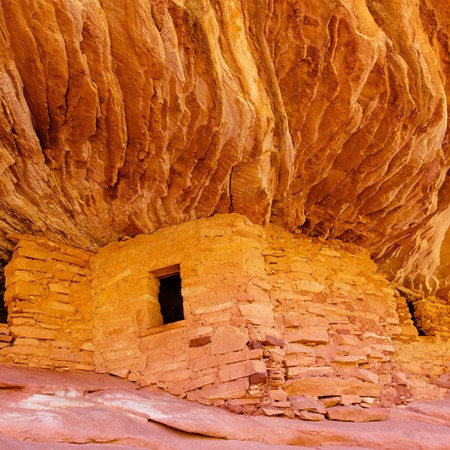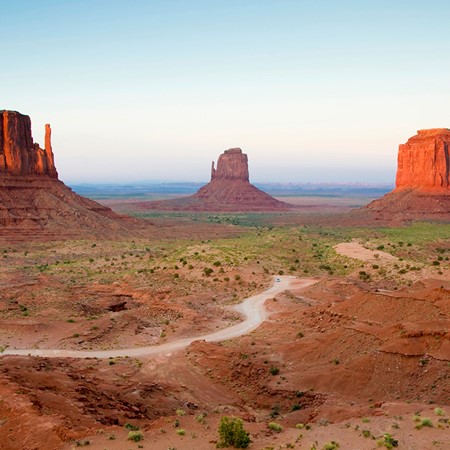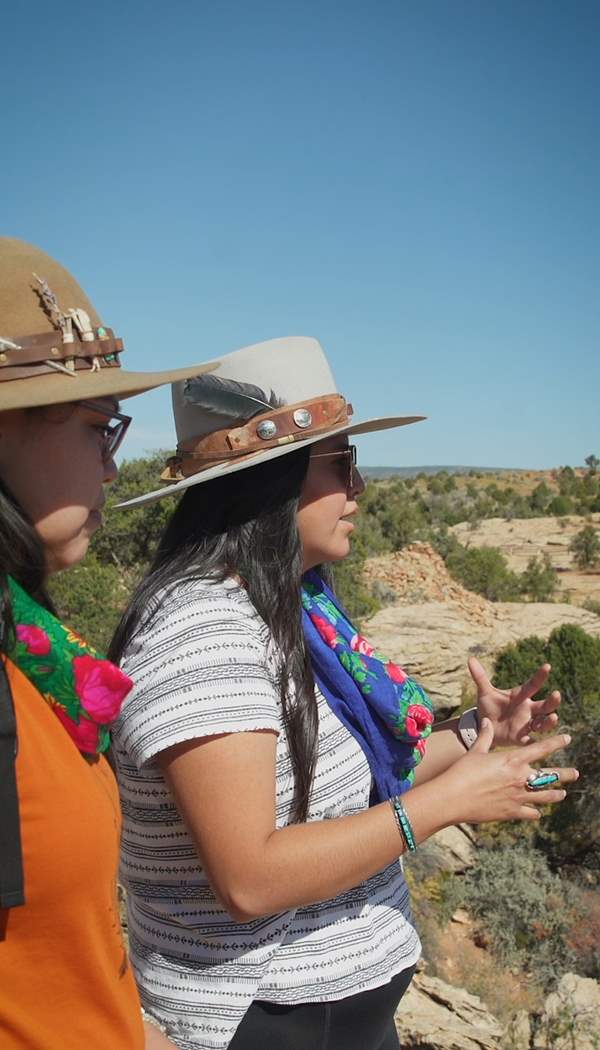Native Spirit
Explore the West's ancestral past. Visit the sacred lands of the Navajo. Travel with respect.
Countless generations of Native Americans have called the landscapes of Utah home, from the hunter-gatherers of the prehistoric era and the Ancestral Pueblos who built cliff dwellings in Bears Ears National Monument to the more than 60,000 Native Americans who live in Utah today. This six-day itinerary will paint a vibrant picture of Utah’s heritage as you visit dwelling sites, petroglyphs, and other places steeped in Native American culture and present-day history.
Start things off with a visit to the Natural History Museum of Utah and This Is The Place Heritage Park then give yourself a couple of days to tour Nine Mile Canyon and the backcountry roads of the San Rafael Swell to see some of the state's finest petroglyph and pictrograph sites. First-time visitors might start the trip in Arches National Park, where just off the trail to Delicate Arch lie ancient Ute petroglyphs. (But plan with care: The park gets busy and patience is a must. Check traffic in advance and know that weekends will be especially busy.) Head south toward the Indian Creek Corridor Scenic Byway unit of Bears Ears National Monument for a stop at Newspaper Rock, where you’ll find hundreds of petroglyphs etched into the cliffside and dating as far back as 2,000 years.
Around Blanding and Bluff, you can visit Edge of the Cedars State Park Museum to explore an ancient Pueblo village, as well as Hovenweep National Monument and its castle-like remnants of a massive ancient village. Then marvel at the 100-yard panel of petroglyphs at Sand Island. With high-clearance, a map, preparation and respect, nearby Comb Ridge offers a closer look at this land's indigenous history.
Take a Jeep tour of Monument Valley with a Navajo guide who will teach you about Navajo culture, storytelling, and this breathtaking landscape they call home. Get a closer look by walking the Wildcat Trail that loops around West Mitten Butte. If you've seen even a few Hollywood Westerns, chances are, this place will seem familiar.
On your final day, explore the rugged Cedar Mesa area where you’re bound to discover with humility and care the ancient cliff dwellings along S.R. 95 and countless relics scattered throughout the canyons. Or visit the largest known Fremont Indian village and its artifacts, petroglyphs and pictographs as well as the impressive range of animals depicted in the petroglyphs of Capitol Reef National Park.

Salt Lake to Nine Mile Canyon
300 Miles
Many themed trips through Utah get their best start at the Natural History Museum of Utah, the "trailhead to Utah." For an immersive experience, you can explore three different types of traditional native dwellings at the Native American Village at This Is The Place Heritage Park. Departing Salt Lake City (for extended stays read Salt Lake City's Iconic Sights and the Cool Kids Guide to Salt Lake) with provisions for a road trip, pick up maps and stop for coffee or lunch in a gateway community like Helper. From Helper, take the half-day spur trip up the rolling and paved scenic drive of Nine Mile Canyon, known as the world's longest outdoor art gallery. (Read: A Rural Community Leading the Way in Stewardship and Preservation)
At this time, it might be best to overnight in Helper or Price, adding time for Price's Utah State University Eastern Prehistoric Museum. (Read: A Deep Dig into Utah's Deep Time)

Buckhorn Wash in San Rafael Swell
161 Miles
The next day, head south on S.R. 10 toward the welcoming communities of Huntington and Castle Dale before turning east down the unpaved BLM backroads into the heart of the San Rafael Swell. It's slower travel but worth it. Consider a visit to the scenic Wedge Overlook into the Little Grand Canyon then head toward the Buckhorn Wash pictograph panel, one of the state's most extraordinary rock art sites amid rugged and wild landscapes.
Overnight: Green River

South to Bears Ears
200 Miles
- Indian Creek Corridor Scenic Byway
- Edge of the Cedars
- Bears Ears National Monument
- Mule Canyon's House on Fire and Cave Tower
First-time visitors could consider a well-timed visit to Arches National Park (note that from April 1 through October 31, daytime visitors to Arches are required to have a timed entry ticket to enter the park). The distinctive petroglyph panel inside the park begs the question: What did early indigenous people think of these magnificent landforms? After Arches, head south toward the Indian Creek Corridor Scenic Byway (within Bears Ears National Monument) to the Needles District of Canyonlands for a stop at the historic Newspaper Rock. If time permits, explore Cave Spring of Canyonlands, or continue on to Edge of the Cedar State Park Museum to familiarize yourself with the archaeology of the Four Corners region. For well-prepared travelers with time, nearby Mule Canyon and Butler Wash offer excellent introductions to Bears Ears-area ancestral sites. Bears Ears National Monument Day Hiking passes are required year-round for day hiking in the Bears Ears National Monument, visit recreation.gov to obtain a pass.
Overnight in Monticello, Blanding or Bluff.

Edge of the Cedars to Bluff
40 Miles
Ancestral Puebloan sites are simply astonishing. From the cliff dwellings along S.R. 95 to the precariously perched multi-story structures of Hovenweep National Monument, these were ingenious people. Imagine living off the land in Utah’s stark Canyon Country and the rugged Four Corners. Fast forward several centuries to the advent of U.S. western expansion and the emergence of Navajo fry bread out of a time of struggle. The dish is common in San Juan County and an excellent accompaniment to your exploration. Overnight in Bluff.

Bluff to Monument Valley
60 Miles
Start the day with easily accessible Sand Island Petroglyphs located along the San Juan River. More adventurous families may fill up today rafting the gentle rapids of the river for unique angles on more fascinating rock art. Otherwise, Monument Valley Navajo Tribal Park awaits. Book a Jeep tour in advance to get the best access to the park. There are tours of varying lengths, but be sure to save time for the Wildcat Trail, the only self-guided trail in the park. Overnight in the park or nearby Mexican Hat.

Cedar Mesa to Fremont Indian State Park
275 Miles
Most of the hikes in Cedar Mesa explore ruins, artifacts, and the rock art of the land’s former inhabitants. It’s clear why local tribes are rallying to protect the landscape. For now, hikers with wayfinding skills can grab a permit for treks into the remote lands or simply enjoy the drive up S.R. 261 with stops at overlooks to appreciate ancient life. Continue to Capitol Reef National Park, where evidence of prehistoric people abounds among the park’s seemingly endless trail system. Finish at Fremont Indian State Park, a happy accident of freeway construction.














